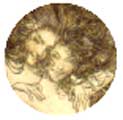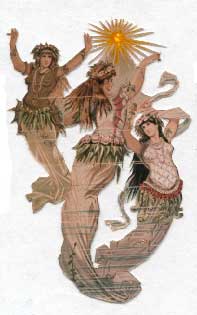Meet the Characters
Any
drama from the classic repertoire benefits from several commented
editions. Traditionally, they explain not only the springs of the
main and the secondary intrigues, but also the meaning of the characters.
In case of Shakespeare, Molière or Beaumarchais, they rarely
have to appeal to Jung, Freud or Levy Strauss to enlightenment.
Most of the time, acute mind and classic "psychology"
are sufficient. The characters are presented neither as psychoanalytical
entities, nor as socio-political symbols.
They
are characterized individualities that nevertheless represent common
or exceptional kinds. Naturally, one can apply this conventional
typology to the characters of the Ring; moreover this is a usual
approach of commentators from Alfred Ernst to Holman, including
the extreme sensibility of analysis by Stéphane Goldet. We
to present the characters in a way as synthetic as possible and
we avoid most of the learned or audacious hermeneutics. We shall
comment on the characters in the order of their appearance.
The
Characters of " Das Rheingold "
Read Synopsis
Woglinde,
Wellgunde, Flosshilde.
These
three Rhine maidens were the targets of uncountable speculations.
J.J.Nattiez assimilated them respectively to music, to dance and
to poetry. Flosshilde, the most careful and wise of the naiads,
who is destined at the end of the Ring to brandish the Ring, is
the verb, the poem. Her importance reflects that of the "Wort"
with regard to the "Ton".
 |
At
the time of the writing of the "Rhinegold", that
is when he was under influence of his ideas expressed in Opera
and Drama, Wagner would have used the girls of the Rhine as
metaphor of three factors of the drama.
This interpretation is in a crass contradiction with "girls
of fortune" or "whores" interpretation. Now,
the relationship between a prostitute and her "client"
is exactly the opposite of that between the nixes and Alberich.
The sex-worker girl tries to extort some gold from her pray
in exchange for her charms. In Rhinegold, the presumed "whores",
not just refuse the charms to their prey, but do everything
to drive him crazy and urge him to ransack them!
|
The
most known and doubtless the most successful graphic representation
of ondines is that by Arthur Rackham. They appear as born from the
liquid element, and the Art Nouveau graphics of the draftsman marvellously
express them by their shapes and curves. To a certain extent they
are very close to the person of Loge. The same fluidity, the same
contradictory attitude, the same irony, and especially the same
perversity.
These
creatures are inclined to play. For them everything is subject to
mockery and naughtiness. Their laughter is hard and cruel. Alberich
is hurt in the deepest of his the pride by their aggressive "
ha-ha-ha-ha ". This laughter is transformed into a real roar
of jubilation when the sun of dawn illuminates the summit of the
cliff. It is the famous cry: "Rheingold! Rheingold!" The
gold shines like the sun in the stream. The Rhine maidens identify
it with the splendours of nature.
|
More
than other characters the Rhine maidens are described by music.
From the beginning of the tetralogy they introduce the famous
apology of desire, the longing and the seduction, the inflection
6-5, the major-dominant sixth. This inflection is one of the
most important constituent motives for drama. When orchestrated,
it gives the famous "Rheingold", in minor, the universal
complaint. Wagner demonstrates repeatedly the relationship
between seduction and complaint, by oscillating as by play
from one to another. Their theme is inseparable from the image
of the undulating waves, the latter coming from the theme
of the Rainbow.
|
|
The Rhine maidens represent the virgin nature, prior to the destructive
effects of civilization. Wagner expresses this "primitiveness",
by the verb (archaic forms), the images (the nautical evolution),
the sound (the pentatonic, later found in the song of the bird;
the Chinese pentatonic mode was considered primitive in the XIX-th
century).
 |
One
of the keys of the behaviour of the Rhine maidens is their age.
You do not need too much imagination to understand that they
are very young, almost children. Their way to express themselves
and to move around proves it; the music is even more eloquent.
When the third naiad mocks Alberich, the trio swims to the tune
of childish circle dance. |
You have to be stone deaf to see them as very mature pipe smoking
ladies, laying on a Victorian couch, and not to roguish kids. Even
if they are endowed with this premonitory gravity which one meets
in exceptionally gifted children!
Siegfried
and Brünnhilde are systematically over aged in practically
all the stage settings, for an evident practical reason: without
the playback, how is it possible to have actors in the adolescent
physical appearance endowed with a voice of grown-up singers?
|
This
problem does not arise for the less binding roles of the Rhine
maidens. But there is another crippling handicap: the censorship.
The usual image on illustrations shows the girls courted by
a deformed and libidinous old man, can pass if need be thanks
to the effect of distance of the graphics.
But let us try to imagine the dramatic art of Chéreau
associated to the prints of Rackham! Alberich repeatedly buries
his head under the skirt of mature ladies endowed with generous
bosoms who embrace him without ambiguity.
What is already dirty would become unbearable with a deformed
dwarf and nubile girls described by Donnington! The director
has no other choice but to make the nixes older if he wants
to protect from the violent eroticism of the scene.
|
|
For example Harry Kupfer represented the Rhine maidens in Bayreuth
as sex symbols of porno comic strip, with high heels boots and leather
clothes. Let us not forget that Wagner on the eve of his death declared
his tenderness for the girls of waters. Their play with the pretenders
was aimed only at distracting them from the main part: the gold,
by focusing on the secondary: sex.
 |
![]()

![]()








